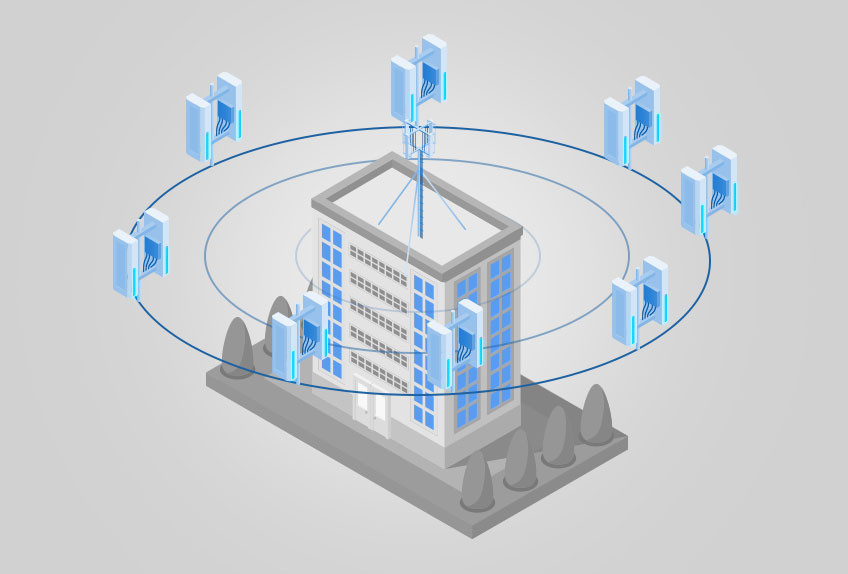Distributed Antenna Systems or DAS has made amazing technological advancements to meet today’s demand for uninterrupted cellular connectivity. An increasing number of both commercial and residential spaces are adopting DAS to boost their in-building cellular connectivity which comes with its own advantages. With the initiatives from the National Fire Protection Association (NFPA) and the International Code Council (ICC), there is the nation-wide implementation of model codes for public safety in-building communications which is further fueling the need for robust in-building DAS solutions.
Implementing DAS is a complex procedure and requires the solution provider and the facility owner to work in close coordination to support the increasing demand for reliable and high-performance communication inside the facility.
Details to look out for while designing an in-building DAS
Before one decides on using DAS to improve network connectivity, one must know that the DAS antenna design will be different for different building and it depends on a variety of factors such as the usage of the building, how it is made, and specifics of the issue we are trying to resolve using DAS.
To truly understand the methodology for a DAS design it is important to understand briefly how DAS works. DAS is a network of coax or fiber optic cables and indoor antennas that sends and receives signals on the carrier’s licensed frequency to improve the voice and data quality of the residents inside the building. When it comes to implementing DAS there isn’t one size that fits all. Every DAS implementation is unique to the requirements or performance DAS is trying to fulfill.
Design methodology for a DAS design
- Up-to-date blueprint of the building: The first step to implementing DAS is an up-to-date and accurate blueprint of the building. The blueprint of the building is necessary for the engineers to understand the floor plan and places where the signal needs to be amplified. Building a DAS solution changes depending is the building is new or an existing one. For an existing building implementing DAS will require extensive site survey tools to test signal quality and RF interference. For new buildings, the DAS implementation starts at the pre-construction stage. A provisional RF design is prepared with the building plan basis the structure, building material, and floor plan.
- Physical information related to the building: Knowing the physical information on the building such as the building materials used both on the outside and inside of the building. Knowing the building materials used helps the engineers understand the RF blockage in the building. The engineers should also know about the aesthetic restrictions that might not allow the placing of boosters, cables, or any visible hardware in the building
- Coverage vs Capacity: These are the two reasons why a DAS solution is implemented. Depending on the usage of the facility the need for DAS changes. For instance, in a large stadium with a large crowd, the local network from the near-by tower gets insufficient in providing coverage to all the people in the stadium. In this case, the DAS solution is designed to provide higher capacity. While for buildings where there is a lack of enough usable signal inside, the primary objective of DAS is to increase coverage.
- Design for the future: While designing for a DAS solution, it must be designed with the future in mind. Considering the CAPEX involved in implementing DAS, it should be designed with a flexible architecture that allows easy addition of channels and frequencies.
Steps for building a best-in-class, scalable Distributed Antenna Systems (DAS)
Step 1: Site Surveying & Benchmarking
Inspect each building utilizing the latest RF equipment. This is done to figure out the key characteristics of the structure such as materials, carrier signals, key passageways, and locations for equipment placement within the building.
Step 2: Plan Design
Based on the data collected during the site survey, a plan design is then created using industry-standard design software to provide a solution that enhances coverage and capacity to all in-building areas for all cell phone carriers.
Step 3: Installation & Commissioning
Once the plans are in place, a team of integrators installs the necessary equipment at the chosen place through the facility. This must be followed by fine-tuning each installation for maximum performance that keeps the system on-air for the long term while ensuring all mobile network operators are connected and their signal is amplified.
Step 4: Post Installation
Review The project manager should engage and monitor the project status ensuring smooth deployment, installation and commissioning of the system.
Step 5: Post Installation
Support The Distributed Antenna Systems (DAS) solution provider must customize a support program that meets business needs and expectations of the communications infrastructure put in place.
Outro: At Kaytech Coverage we ensure our DAS solutions are customized to meet the exact need of the end-users. We’ve worked with several marquee customers including Microsoft, CarMax, and Watlow while also commissioning more than 300 installations across verticals. So if you’re in the market for DAS solutions to boost your business, then reach out to us by visiting https://ktcoverage.com/contact; and we’ll be certain to help you through the entire DAS process.


